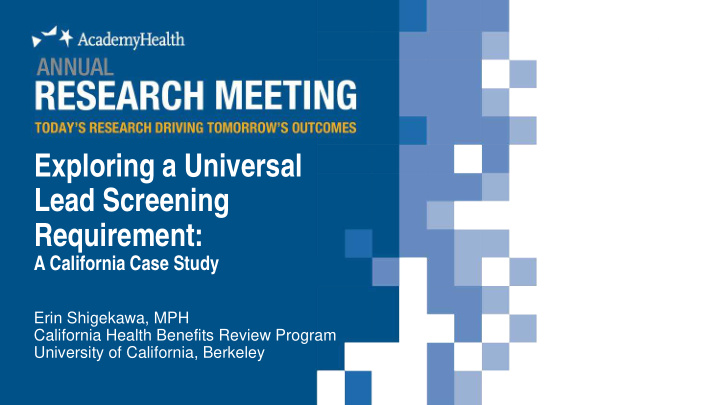



1 Exploring a Universal Lead Screening Requirement: A California Case Study Erin Shigekawa, MPH California Health Benefits Review Program University of California, Berkeley
Co-Authors 2 • Sara McMenamin, PhD, MPH, UC San Diego • Sarah Hiller, MPIA, UC San Diego • Riti Shimkhada, PhD, MPH, UCLA Center for Health Policy Research
Overview 3 • The California Health Benefits Review Program • State Activity in the Social Determinants of Health • California Case Study: Lead Screening Bill • Challenges and Considerations
The California Health Benefits Review Program 4 • Independent and objective resource that provides evidence-based analyses for the California Legislature • Analyzes current bills at the request of the Legislature • 3 areas: Medical effectiveness, cost and use, public health • Timely, rigorous analyses produced in 60 days or less
The CHBRP Team 5 • Team model: • Central staff at UC Berkeley • Faculty and staff task force from several UC campuses • Actuaries • Medical librarians • Advisors and reviewers: • Content experts • National Advisory Council
State Activity in the Social Determinants of Health 6 • Medicaid waivers and pilot programs • State task forces (e.g., Health in All Policies) • Legislation • Screening and testing policy • Coverage of services
California Case Study: Lead Screening Bill 7 • No level of lead in the body is known to be safe. • Common sources of lead include: • Lead-based paint (pre-1978); • Lead contaminated soil and dust; • Some foods, cosmetics, and dishware with leaded glaze.
California Case Study: Lead Screening Bill 8 As introduced, Assembly Bill 1316 would require: • State-regulated insurance to provide coverage for blood lead level testing of all children 6-72 months (rather than only those “at-risk”) • Targeted universal • Essentially changes standard of care • Appropriate case management if lead poisoning identified (via Department of Public Health)
Medical Effectiveness Findings 9 • Individual Level: • Damage is irreversible • Possible to minimize further exposure • Population Level: • Insufficient evidence that a universal screening approach is more effective than a targeted approach
Public Health Impacts 10 • Individual Level: • 4,800 additional children with elevated blood lead levels would be identified in year one; mitigation • Population Level: • Potential for future identification of lead exposure “hot spots” lead abatement, prevention on community level requires action by other state agencies, stakeholders
Challenges and Considerations 11 • Complexities for policy makers • Evidence, resources, potential harms of exposure, intervention • Impacting social determinants through legislation • By definition, issue is broader than health care delivery • May require coordination of multiple state agencies
12 California Health Benefits Review Program www.chbrp.org @CHBRP_at_UC
Recommend
More recommend